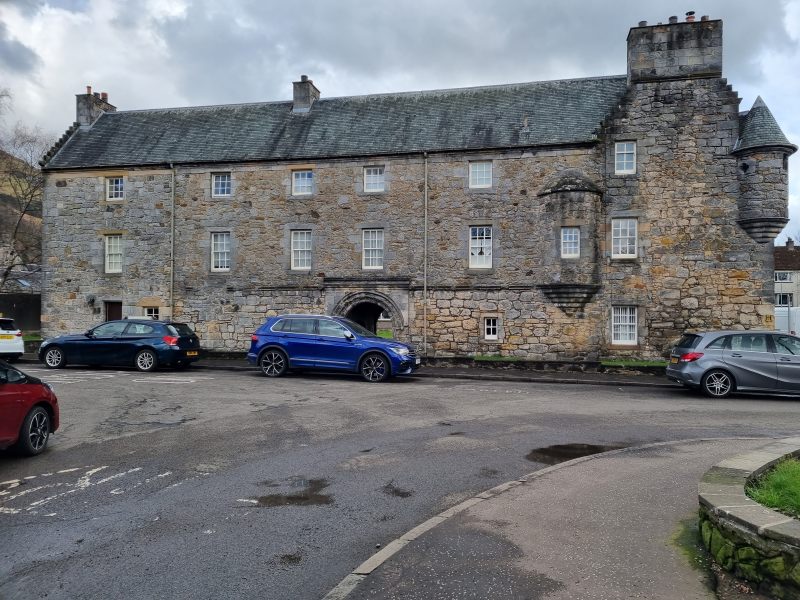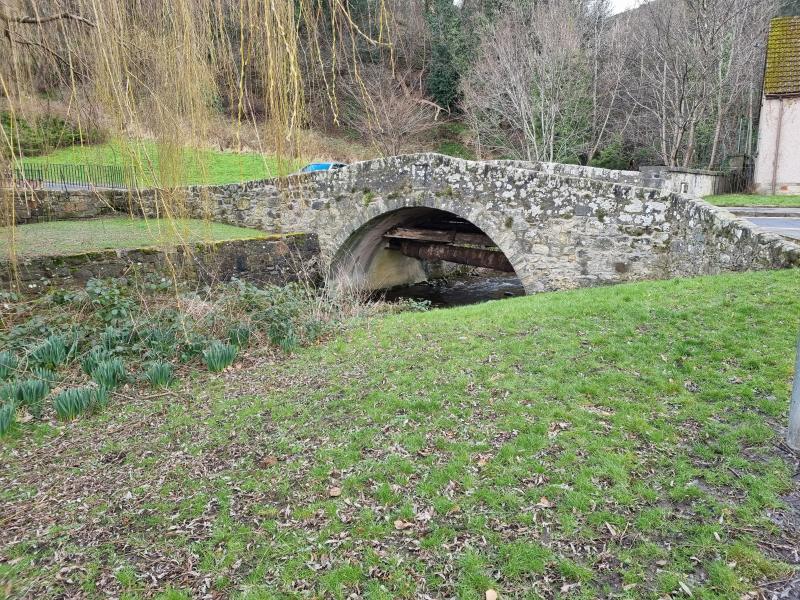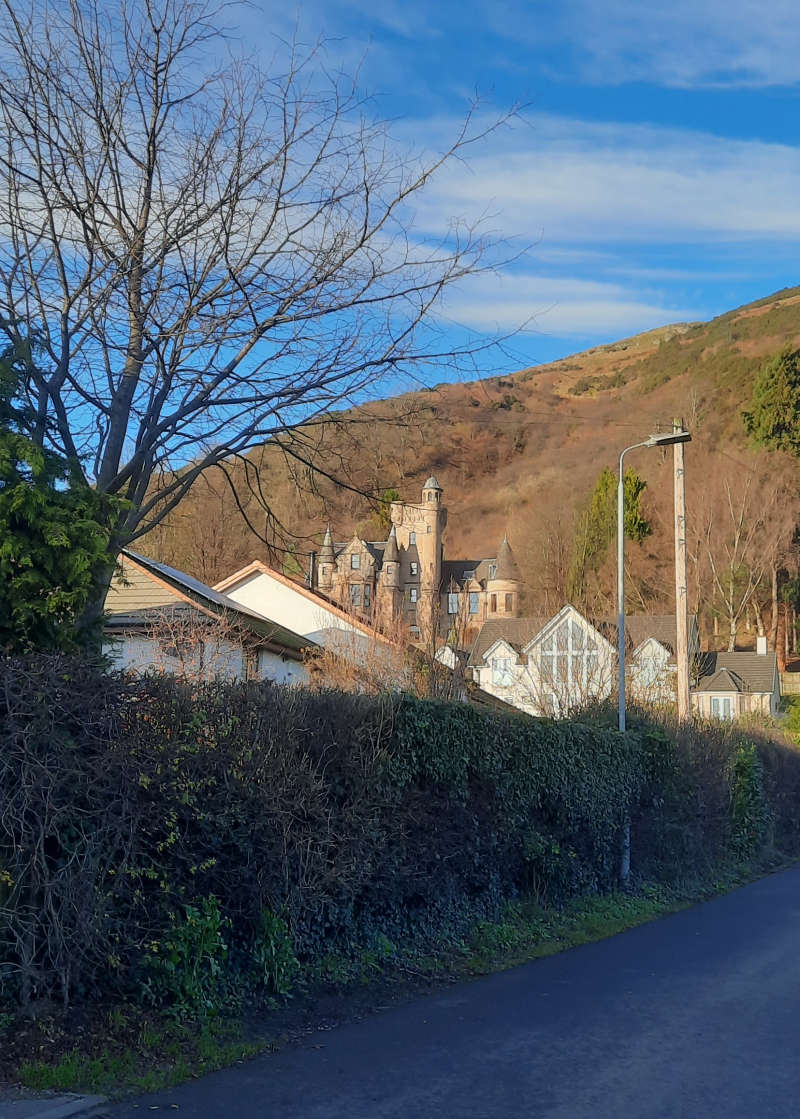Menstrie is now the westernmost of the 'Hillfoots' villages within Clackmannanshire and boasted a population of 2870 in 2016.
Menstrie stands on the carse of the river Devon, just 10 to 20 metres above sea level. It is roughly over the Ochil geological fault whose movement gave rise to the dramatic southern slope of the Ochils. Two of the most westerly summits of the Ochil Hills, Dumyat and Myreton Hill, rise steeply to the north of the village to reach about 400m altitude. These two hills are divided by Menstrie Glen, from which the Menstrie Burn emerges and runs through the village. On the hills above Menstrie, Lossburn Reservoir, extended around 1914, supplies water to Clackmannanshire. To the south of Menstrie, the burn joins the river Devon which in turn meets the river Forth at Cambus.
Menstrie Glen has traditionally been used for sheep farming. However, a large part of it is now used for commercial forestry, with a strip of mixed woodland planted closest to Menstrie Burn. Menstrie is on the A91 road from Stirling to St Andrews.
The occupants of Menstrie once processed wool from sheep farmed on the Ochils. In 1800, businessmen from Tullibody set up a carding and spinning mill on the east side of the Menstrie Burn to exploit its soft water and the water power of the burn.
In the early 19th century, a straight road was built on the flat ground of the carse to bypass the old Hillfoots Statute Labour Road and improve the transport of goods to and from the Hillfoots villages. Menstrie's Long Row and Ochil Road lie on the original route which winds along the foot of the hills. The new road, now the A91, became a focus for construction of churches, houses, mills and shops, and the Hillfoots villages all re-centred around this superior road.
By the mid-19th century, the Elmbank and Forthvale mills were in business on either side of the Menstrie Burn. In 1841, Menstrie's population was about 500 but had increased to more than 900 by 1881.
In the 1860's a company, which included the owners of local mills and a distillery, financed a branch railway line through Menstrie to a terminus in Alva. This joined the Stirling and Dunfermline line between Alloa and Stirling at Cambus. Menstrie had its own railway station which was open to passengers from 1863 until 1965. Nothing of the station remains or the railway branch line, which continued to carry freight until the 1980's. It is now being used as a pedestrian path and cycleway, which links Cambus, Tullibody and Menstrie. The path now forms part of National Cycle Network Route 768. There has been talk of extending the path along the old track bed route from Menstrie to Alva, though this plan has not as yet come to fruition.
The Glenochil Distillery had opened in the middle 18th century on the site of the Doll Farm to the east of the village, beside the Dams Burn. At its peak, around one million bottles of grain whisky were made here. Manufacturing has continued on this site for more than 250 years, though production of whisky stopped around 1930. Yeast, initially a by-product of whisky fermentation, had gradually become the main business and was produced for the manufacture of whisky and bread. Soft water, locally available, is still useful. An extensive bonded warehouse area remains for storage of whisky as it matures in barrels before bottling, while bakers' yeast has given way to fermentation products derived from yeast.
The whisky and yeast businesses are now operated by separate companies, namely Diageo, (successors to Distillers Company Limited (DCL)) and Kerry Group. The latter conducts product development as well as manufacturing at the Menstrie site.
The Forthvale Mill no longer stands but the Elmbank Mill now houses small businesses.
By the mid-20th Century, Menstrie had a population of around 1200. Employment in the area included coal mining and textiles. Since then the village has become home for those commuting further afield for work, and the village has further expanded.

"Fox Boy" - sculpture by Andy Scott
"Fox Boy", a work by the sculptor Andy Scott, stands in the centre of Menstrie. The sculpture combines references to the water wheels that once powered industry in Menstrie, a pet fox kept by a Menstrie child years ago, and the buzzards that frequent the skies over the village. The flag of Nova Scotia is flown alongside the flag of Scotland, highlighting Menstrie's role with the settlement and development of Nova Scotia.
Menstrie and the nearby Blairlogie are popular access points for hillwalkers to Dumyat, a peak in the Ochil Hills and from Menstrie to Myreton Hill, the zig zag hillside path from Ochil Road is used by mountain bikers and hillwalkers.

Menstrie Castle
Menstrie Castle was the birthplace of Sir William Alexander, James VI's Chartered Lieutenant for the Plantation of Nova Scotia. 2021 was the 400th anniversary of this event. Despite its name, it is described as a "three-storey castellated house", and lacks many fortified features, standing as it does on low ground and constructed at a time of relative national calm. The building is now residential and has won a Civic Trust award. The National Trust for Scotland operate a small museum exhibition commemorating the link between Menstrie, William Alexander, and Nova Scotia and is open to the public.

The pre 19th century bridge known as Auld Brig adjacent to the Scout Hall over the Menstrie Burn is listed by The Royal Commission on the Ancient and Historical Monuments of Scotland. A vital link on the old Statute Labour Road, a bridge has been recorded here since 1665.
In 1874, James Johnstone, one of the partners in the Elmbank Mill, had built for himself the Scottish baronial-style Broom Hall on the lower slope of Myreton Hill.

It operated for a time as a private Boys School called Clifford Park. It was burned out in the 1940s and stood as an abandoned shell until 1985 when it was converted into a nursing home. It has since been refurbished and operates a restaurant and bar and is a popular wedding and event location.
The war memorial was erected in 1922 and lists those killed in the World Wars. The bulk of those killed in the First World War were in the 7th Battalion Argyll and Sutherland Highlanders. In June 2016 a plaque was unveiled at the war memorial remembering the Polish soldiers who were stationed in the village.
References:
